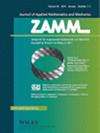温度场下表面效应对梯度多孔米德林圆纳米板轴对称振动的影响
IF 3.2
4区 工程技术
Q1 MATHEMATICS, APPLIED
Zamm-zeitschrift Fur Angewandte Mathematik Und Mechanik
Pub Date : 2023-10-31
DOI:10.1002/zamm.202300590
引用次数: 0
摘要
摘要表面效应对纳米材料的力学响应有显著影响。本文将Gurtin - Murdoch表面弹性理论引入Mindlin板理论,研究了梯度多孔圆形纳米板在温度场中的轴对称振动特性。主要结构是多孔梯度材料,其厚度具有均匀或不均匀的孔隙率分布。采用数值射击技术求解由哈密顿原理导出的控制微分方程。得到了梯度多孔纳米板在固支和简支边界条件下的振动特性响应。数值结果表明,当去除表面效应时,得到的是经典的明林圆板的结果。固有频率和模态振型随热系数和孔隙系数变化的图形表示。然后详细讨论了表面材料性能对纳米板轴对称振动特性的影响。参数化研究考察了孔隙系数、孔隙分布方式、表面弹性参数和残余表面应力对多孔圆形纳米板振动特性的影响。本文章由计算机程序翻译,如有差异,请以英文原文为准。
The influence of surface effects on axisymmetric vibration of graded porous Mindlin circular nanoplate in a temperature field
Abstract The surface effect significantly affects the mechanical response of nanoscale materials. In this work, we introduce Gurtin‐Murdoch surface elasticity theory into Mindlin plate theory to study the axisymmetric vibration characteristic of graded porous circular nanoplate in a temperature field. The main structure is a porous graded material with uniform or non‐uniform porosity distribution in its thickness. The numerical shooting technique was applied to solve the governing differential equations derived from Hamilton's principle. Responses for the vibration characteristic of the graded porous nanoplate for both clamped and simply supported boundary conditions were obtained. The numerical results show that when the surface effect is removed, the classical results of Mindlin circular plate will be obtained. Natural frequencies and mode shapes varying with thermal and porosity coefficients were present graphically. And then the effects of surface material properties on the axisymmetric vibration characteristic of the nanoplates were discussed in detail. The parametric study examined the influence of porosity coefficient, porosity distribution mode, surface elastic parameters, and residual surface stress on the vibration characteristics of porous circular nanoplates.
求助全文
通过发布文献求助,成功后即可免费获取论文全文。
去求助
来源期刊
CiteScore
3.30
自引率
8.70%
发文量
199
审稿时长
3.0 months
期刊介绍:
ZAMM is one of the oldest journals in the field of applied mathematics and mechanics and is read by scientists all over the world. The aim and scope of ZAMM is the publication of new results and review articles and information on applied mathematics (mainly numerical mathematics and various applications of analysis, in particular numerical aspects of differential and integral equations), on the entire field of theoretical and applied mechanics (solid mechanics, fluid mechanics, thermodynamics). ZAMM is also open to essential contributions on mathematics in industrial applications.

 求助内容:
求助内容: 应助结果提醒方式:
应助结果提醒方式:


